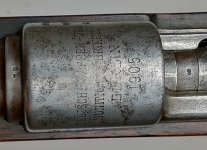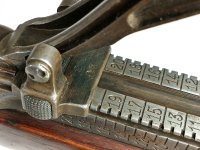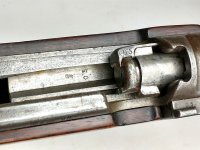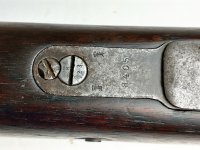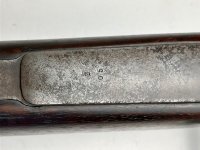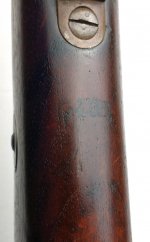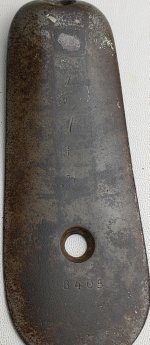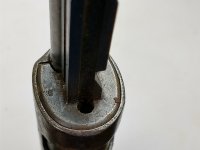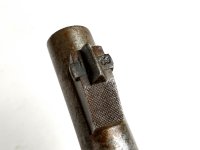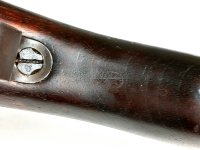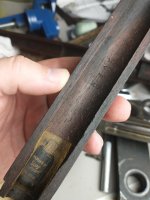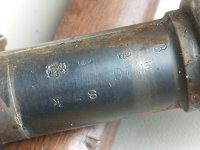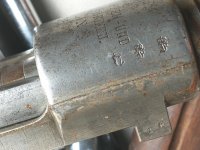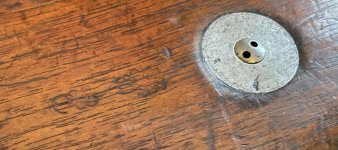Hi All,
I've got a bit of a backlog of postings, so I'll try to work backwards over the next several weeks to document these.
I picked this one up on GB after Sam's coaxing that it needed to be saved. The rifle had its fore end shortened to right in front of the rear band spring and the lip of the handguard was cutback as well. No other major changes were made to the rifle. I was able to get it pretty cheaply through an offer to the seller. Here is the "before"
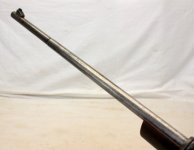
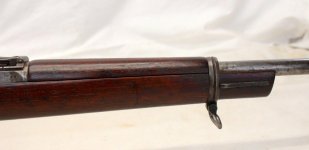
I cut the stock back to just in front of the cleaning rod lug to do a faux duffel cut, I was able to take a spare fore end, an extra band that was matching in patina and an armorer's bayonet lug to repair the front. Fortunately the color of the fore end was near identical and really ended up looking nice.
With the rifle fixed, here is some commentary--- The rifle matches except for the bands, rear action screw and rear sight leaf. It's an old warhorse and the metal has almost no finish remaining. The bolt and triggerguard assembly are factory, which is pretty cool for a 1905 date. The rifle made two separate trips to Rastatt, as evidenced on the buttplate. It appears the stock was an armorer's replacement, as I cant see any side acceptance. The disc was flipped, so I checked the back and was pleasantly surprised to find a 5th Jager Regiment unit marking. Nice bonus! The markings on the keel and wrist are faint-- I lean more toward a light sanding than wear, as the bottom is smooth.
In any case, it was a nice and inexpensive fix that turned out pretty good. I'll admit, my pictures of the stock interior and a few other internal shots didn't save right, so we'll have to go without until I take apart again lol.
Data:
Receiver 8405 d
Barrel 8405 d Bo 16
Front Sight 05
Rear Sight Leaf mm
Sight Slider 05
Ejector Box 05
Trigger Sear 05
Front Barrel Band mm
Rear Barrel Band mm
Trigger Guard 8405
Trigger Guard Screws mm, armorer
Floor Plate 05
Follower 05
Stock 8405
Handguard 8405
Buttplate 8405 d (2x Rastatt)
Bayonet Lug armorer
Cleaning Rod none
Bolt Body 8405
Extractor 05
Safety 05
Cocking Piece 05
Bolt Sleeve 05
Firing Pin 05
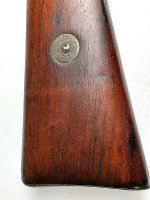
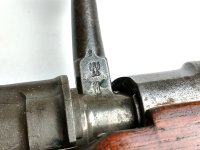
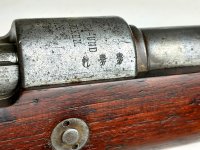
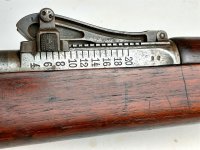
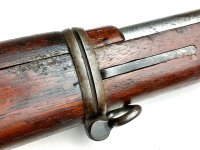
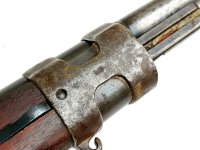
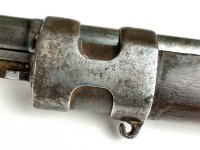
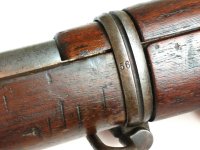
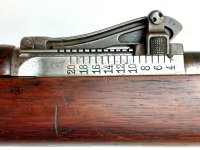

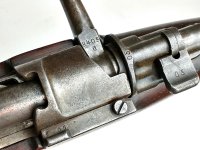
I've got a bit of a backlog of postings, so I'll try to work backwards over the next several weeks to document these.
I picked this one up on GB after Sam's coaxing that it needed to be saved. The rifle had its fore end shortened to right in front of the rear band spring and the lip of the handguard was cutback as well. No other major changes were made to the rifle. I was able to get it pretty cheaply through an offer to the seller. Here is the "before"


I cut the stock back to just in front of the cleaning rod lug to do a faux duffel cut, I was able to take a spare fore end, an extra band that was matching in patina and an armorer's bayonet lug to repair the front. Fortunately the color of the fore end was near identical and really ended up looking nice.
With the rifle fixed, here is some commentary--- The rifle matches except for the bands, rear action screw and rear sight leaf. It's an old warhorse and the metal has almost no finish remaining. The bolt and triggerguard assembly are factory, which is pretty cool for a 1905 date. The rifle made two separate trips to Rastatt, as evidenced on the buttplate. It appears the stock was an armorer's replacement, as I cant see any side acceptance. The disc was flipped, so I checked the back and was pleasantly surprised to find a 5th Jager Regiment unit marking. Nice bonus! The markings on the keel and wrist are faint-- I lean more toward a light sanding than wear, as the bottom is smooth.
In any case, it was a nice and inexpensive fix that turned out pretty good. I'll admit, my pictures of the stock interior and a few other internal shots didn't save right, so we'll have to go without until I take apart again lol.
Data:
Receiver 8405 d
Barrel 8405 d Bo 16
Front Sight 05
Rear Sight Leaf mm
Sight Slider 05
Ejector Box 05
Trigger Sear 05
Front Barrel Band mm
Rear Barrel Band mm
Trigger Guard 8405
Trigger Guard Screws mm, armorer
Floor Plate 05
Follower 05
Stock 8405
Handguard 8405
Buttplate 8405 d (2x Rastatt)
Bayonet Lug armorer
Cleaning Rod none
Bolt Body 8405
Extractor 05
Safety 05
Cocking Piece 05
Bolt Sleeve 05
Firing Pin 05











Last edited:

